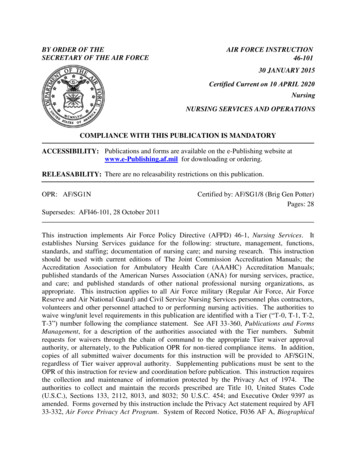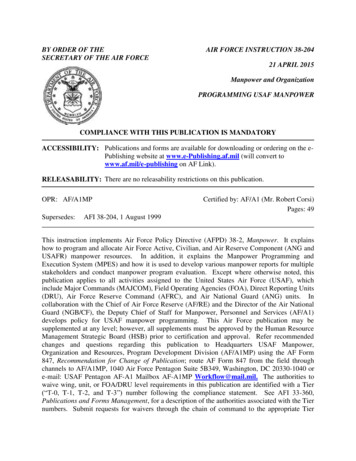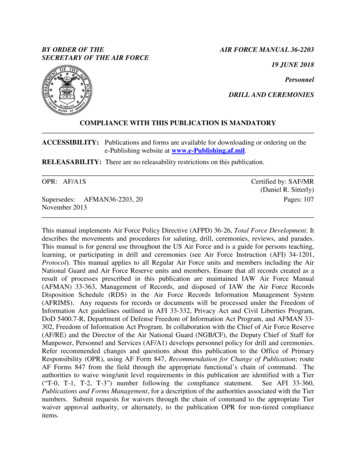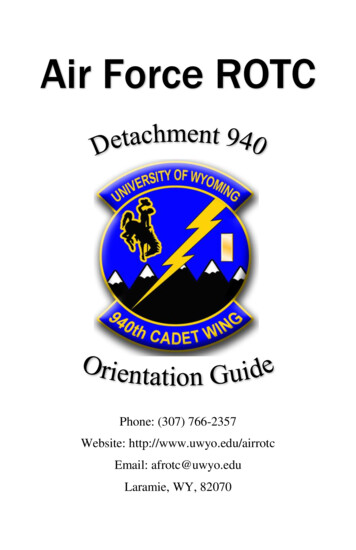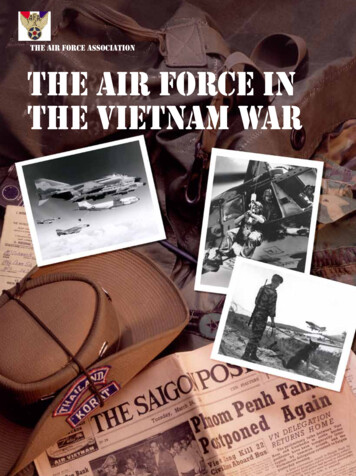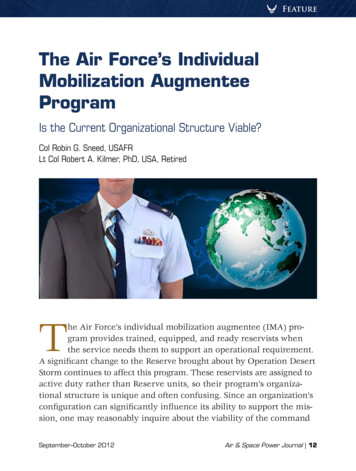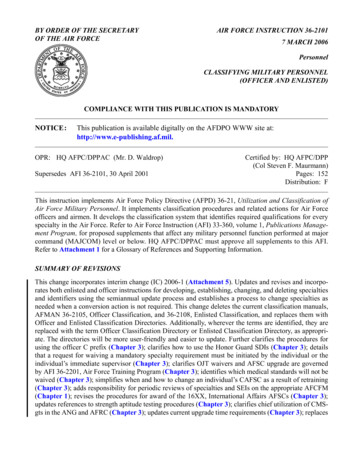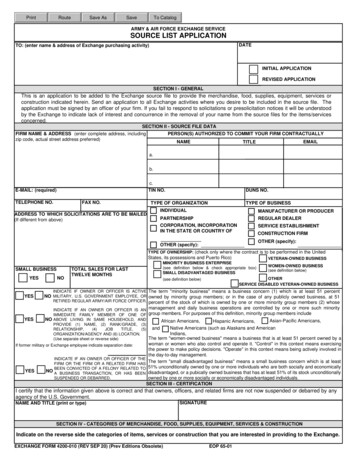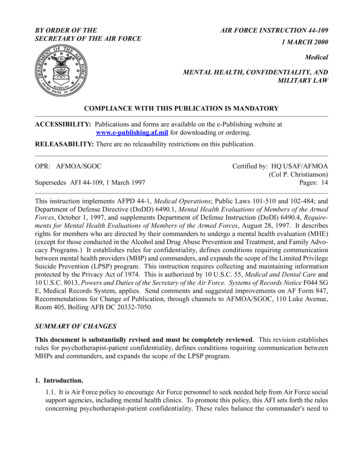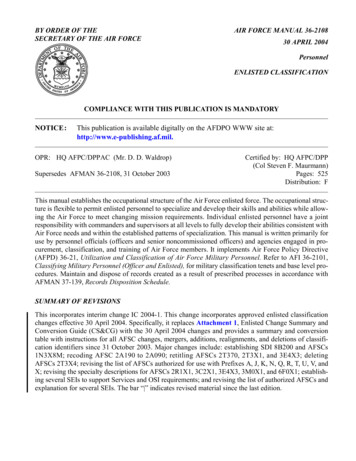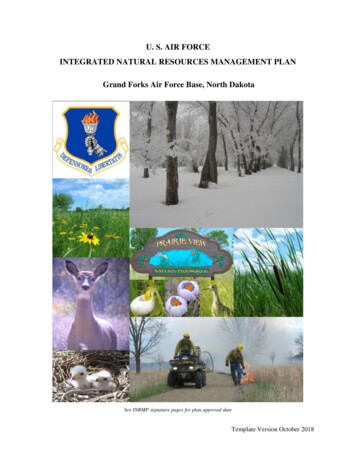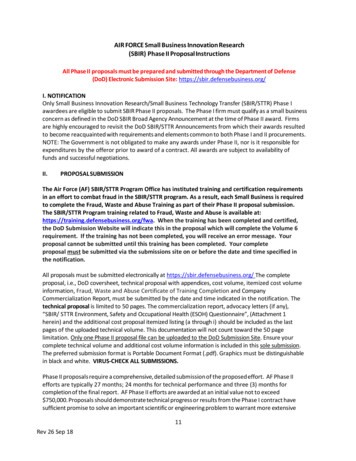
Transcription
AIR FORCE Small Business Innovation Research(SBIR) Phase II Proposal InstructionsAll Phase II proposals must be prepared and submitted through the Department of Defense(DoD) Electronic Submission Site: https://sbir.defensebusiness.org/I. NOTIFICATIONOnly Small Business Innovation Research/Small Business Technology Transfer (SBIR/STTR) Phase Iawardees are eligible to submit SBIR Phase II proposals. The Phase I firm must qualify as a small businessconcern as defined in the DoD SBIR Broad Agency Announcement at the time of Phase II award. Firmsare highly encouraged to revisit the DoD SBIR/STTR Announcements from which their awards resultedto become reacquainted with requirements and elements common to both Phase I and II procurements.NOTE: The Government is not obligated to make any awards under Phase II, nor is it responsible forexpenditures by the offeror prior to award of a contract. All awards are subject to availability offunds and successful negotiations.II.PROPOSAL SUBMISSIONThe Air Force (AF) SBIR/STTR Program Office has instituted training and certification requirementsin an effort to combat fraud in the SBIR/STTR program. As a result, each Small Business is requiredto complete the Fraud, Waste and Abuse Training as part of their Phase II proposal submission.The SBIR/STTR Program training related to Fraud, Waste and Abuse is available at:https://training.defensebusiness.org/fwa. When the training has been completed and certified,the DoD Submission Website will indicate this in the proposal which will complete the Volume 6requirement. If the training has not been completed, you will receive an error message. Yourproposal cannot be submitted until this training has been completed. Your completeproposal must be submitted via the submissions site on or before the date and time specified inthe notification.All proposals must be submitted electronically at https://sbir.defensebusiness.org/ The completeproposal, i.e., DoD coversheet, technical proposal with appendices, cost volume, itemized cost volumeinformation, Fraud, Waste and Abuse Certificate of Training Completion and CompanyCommercialization Report, must be submitted by the date and time indicated in the notification. Thetechnical proposal is limited to 50 pages. The commercialization report, advocacy letters (if any),“SBIR/ STTR Environment, Safety and Occupational Health (ESOH) Questionnaire”, (Attachment 1herein) and the additional cost proposal itemized listing (a through i) should be included as the lastpages of the uploaded technical volume. This documentation will not count toward the 50 pagelimitation. Only one Phase II proposal file can be uploaded to the DoD Submission Site. Ensure yourcomplete technical volume and additional cost volume information is included in this sole submission.The preferred submission format is Portable Document Format (.pdf). Graphics must be distinguishablein black and white. VIRUS-CHECK ALL SUBMISSIONS.Phase II proposals require a comprehensive, detailed submission of the proposed effort. AF Phase IIefforts are typically 27 months; 24 months for technical performance and three (3) months forcompletion of the final report. AF Phase II efforts are awarded at an initial value not to exceed 750,000. Proposals should demonstrate technical progress or results from the Phase I contract havesufficient promise to solve an important scientific or engineering problem to warrant more extensive11Rev 26 Sep 18
research/research and development (R/R&D). Commercial and military potential of the technologyunder development is extremely important. Proposals emphasizing dual-use applications andcommercial exploitation of resulting technologies are sought.All Phase II R/R&D must be performed by the small business and its team members in the United States,as defined in Section 4.2, “Offeror Eligibility and Performance Requirements” of the DoD BAAAnnouncement under which the Phase I was awarded. The primary employment of the Phase IIprincipal investigator must be with the small business concern at the time of award and during conductof the entire proposed effort. Primary employment is defined as more than one-half of the principalinvestigator’s time being spent working for the small business. This precludes full-time employmentwith another organization.Knowingly and willfully making false, fictitious, or fraudulent statements or representations may be afelony under the Federal Criminal Statement Act, 18 U.S.C. Section 1001, punishable by a fine up to 10,000, up to five years in prison, or both.III. PHASE II PROPOSAL PREPARATION INSTRUCTIONS AND PROPOSAL REQUIREMENTSA. Proposal Requirements. A Phase II proposal should provide sufficient information to persuade theAF the proposed continuation of work represents an innovative solution to the scientific orengineering problem and is worthy of support under the stated criteria. All sections below counttoward the page limitation, unless otherwise specified.B. Proprietary Information. Information constituting a trade secret, commercial or financialinformation, confidential personal information, or data affecting national security must be clearlymarked. It shall be treated in confidence to the extent permitted by law. Be advised, in the event ofproposal selection it is likely the Work Plan or Statement of Work (SOW) will be incorporated intothe resulting contract, in whole or part, by reference or as an attachment. Therefore, segregate anyinformation to be excluded from public release pursuant to the Freedom of Information Act (FOIA).See Section 3.9 of the DoD Announcement regarding marking of proprietary information.C. General Content. Proposals should be direct, concise, and informative. Type shall be nosmaller than 12- pitch or 11-point on standard 8 ½” X 11” paper, with one-inch margins andpages consecutively numbered. Offerors are discouraged from including promotional and nonprogrammatic items.D. Proposal Format.(1) Coversheet – Complete and submit the SBIR Proposal Coversheet in accordance with theinstructions provided at https://sbir.defensebusiness.org/. The technical abstract shouldinclude a brief description of the program objective(s), a description of the effort,anticipated benefits and commercial applications of the proposed research, and a list of keywords/terms. The technical abstract of each successful proposal will be submitted to theOffice of the Secretary of Defense (OSD) for publication and, therefore, must not containproprietary or classified information. The term “Component” on the coversheet refers tothe Air Force organization requesting the Phase II proposal. NOTE: This page is notconsidered as part of the 50 page limitation. The technical proposal includes all items listedbelow in the order provided.12Rev 26 Sep 18
(2) Table of Contents – A table of contents should be located immediately after the coversheet.(3) Glossary – Include a glossary of acronyms and abbreviations used in the proposal.(4) Milestone Identification – Include a program schedule with all key milestones identified. Ifoptions are proposed, the schedule should provide notional option start date and period ofperformance.(5) Identification and Significance of the Problem or Opportunity – Briefly reference thespecific technical problem/opportunity addressed in Phase I and its relationship to PhaseII.(6) Phase II Technical Objectives – The proposal should include an assessment of thepotential commercial application for each objective.(7) Phase II Work Plan – If the Phase II requires submittal of a work plan, provide adetailed description of the Phase II approach. At the beginning of the plan, include anoutline in the following format:a. Scope – List the major requirements and specifications of the effort;b. Task Outline – Provide a brief outline of the work to be accomplished over thespan of the effort;c. Milestone Schedule; andd. Deliverables (see paragraph (9) below).NOTE: Proprietary information shall NOT be included in the work plan.The plan should include the location and mechanics of accomplishing the planned approach. Phase IIefforts attempt to accomplish the technical feasibility demonstrated in Phase I, including transition ofresults to the private sector or Government customer. The methods to achieve each objective or taskshould be discussed in detail.The Work Plan must contain separate sections or paragraphs specifically addressing the following:a. Safety requirements are to be followed in the design and performance of theproposed project. If hardware is to be developed, the contract will require atleast a preliminary hazard analysis.b. If the proposed effort involves the use of potentially hazardous materialswith potential risk to personnel or property, the following are required:i. Identification of material;ii. Purpose of the specific material; andiii. Possible alternatives/procedures/safeguards to minimize risk.Complete Attachment 1, “SBIR/STTR Environment, Safety, and Occupational Health (ESOH)Questionnaire” and include it with the proposal. This form does not count toward the 50-pagelimitation.13Rev 26 Sep 18
(8) Proposer-Prepared Statement of Work (SOW) – If the Phase II proposal submission requiresa SOW, it shall be a separate and distinct part of the proposal package, using a page break todivide it from the technical proposal. The proposed SOW must contain a summarydescription of the technical methodology and task description in broad enough detail toprovide contractual flexibility. The following is the recommended format for the SOW; beginthis section on a new page. DO NOT include proprietary information in the SOW.a. 1.0 – Objective: This section is intended to provide a brief overview of thespecialty area. It should explain why it is being pursued and the expectedoutcome.b. 2.0 – Scope: This section should provide a concise description of the work tobe accomplished, including the technology area to be investigated, goals, andmajor milestones. However, the key elements of this section are taskdevelopment and deliverables, i.e., the anticipated end result and/or productof the effort. This section must also be consistent with the information in 4.0(below).c. 3.0 – Background: The proposer shall identify appropriate specifications, standards,and other documents applicable to the effort. This section includes anyinformation, explanation, or constraints to understanding the requirements. It mayinclude relationships to previous, current, and/or future operations. It may alsoinclude techniques previously found to be ineffective.d. 4.0 – Task/Technical Requirements: The detailed description of the individual tasksto accomplish the work to be performed is considered to be legally binding on theproposer. Therefore, it must be developed in an orderly progression with sufficientdetail to establish overall program requirements and goals. The work effort must besegregated into major tasks and identified in separately numbered paragraphs.Each numbered major task should delineate by subtask the work to be performed. TheSOW MUST contain every task to be accomplished; they must be definite, realistic, andclearly stated. Use “shall” whenever the SOW expresses a binding provision. Use“should” or “may” to express a declaration or purpose. Use “will” when nocontractor requirement is involved, i.e., “. . . power will be supplied by theGovernment.”(9) Deliverables – Include a section clearly describing the specific sample/prototype hardware/software to be delivered, as well as data deliverables, schedules, and quantities. Be aware ofthe possible requirement for unique item identification IAW DFARS 252.211-7003, ItemIdentification and Valuation, for hardware. If hardware/software will be developed but notdelivered, provide an explanation. At a minimum, the following reports will be required underALL Phase II contracts.a. Scientific and Technical Reports –The Government obtains SBIR data rights in technicaldata and computer software generated under SBIR/STTR contracts and marked withthe SBIR data rights legend. These rights provide the Government limited rights intechnical data and restricted rights in computer software during the SBIR dataprotection period commencing with contract award and ending five (5) years aftersubmission of the last contract deliverable under the effort which generated the data.Upon expiration of the five year restrictive license, the Government has unlimited14Rev 26 Sep 18
rights to the SBIR data, unless the firm receives another contract under which the SBIRdata rights may be asserted. During the SBIR data protection period, the Governmentmay not release or disclose SBIR technical data or computer software to any personexcept as authorized under limited rights in technical data or restricted rights forcomputer software.i.Final Report – The draft is due 30 days after completion of the Phase II technicaleffort. The first page of the final report will be a single-page project summary,identifying the purpose of the work, providing a brief description of the effortaccomplished, and listing potential applications of the results. The summary maybe published by DoD; therefore, it must not contain any proprietary or classifiedinformation. The remainder of the report should contain details of the projectobjectives met, work completed, results obtained, and estimates of technicalfeasibility.ii. Status Reports – Status reports are due quarterly at a minimum. Phase IIs aregenerally awarded as Fixed Price Contracts. NOTE: Fixed price contracts will receivepayments for each monthly status report or hardware deliverable providedthrough the life of the contract.iii. Phase II Summary Report – The Phase II summary report is due at the end ofthe technical effort and must be submitted via email to your cognizantContracting Officer. Each report should not exceed 700 words and shouldinclude a description of the technology and anticipated applications/benefitsfor Government and/or private sector use.b. Additional Reporting – AF may require additional reporting ordocumentation including:i. Software documentation and users’ manuals;ii. Engineering drawings;iii. Operation and maintenance documentation;iv. Safety hazard analysis when the project will result in partial ortotal development and delivery of hardware; andv. Updates to the commercialization results.(10) Related Work – Describe significant activities directly related to the proposed effort,including any previous programs conducted by the principal investigator, proposing firm,consultants, or others, and their application to the proposed project. Also list anyreviewers providing comments regarding the offeror’s knowledge of the state-of-the-art inthe specific approach proposed.(11) Commercialization Potential –a. The DoD requires a commercialization plan be submitted with the Phase IIproposal, specifically addressing the following questions:i. What is the first planned product to incorporate the proposed technology?ii. Who are the probable customers, and what is the estimated market size?iii. How much money is needed to bring this technology to market and how will itbe raised?15Rev 26 Sep 18
iv. Does your firm have the necessary marketing expertise and, if not, howwill your firm compensate?v. Who are the probable competitors, and what price/qualityadvantage is anticipated by your firm?b. The commercialization strategy plan should briefly describe the commercializationpotential for the anticipated results of the proposed project, as well as plans toexploit it. Commercial potential is evidenced by:i. The small business’ record of commercializing SBIR/STTR or other research,particularly as reflected in its Company Commercialization Report. TheCompany Commercialization Report of prior SBIR/STTR awards may beincluded to satisfy this requirement.ii. The existence of private sector or non-SBIR/STTR fundingsources demonstrating commitment to Phase II efforts/results.iii. The existence of Phase III follow-on commitments for the research subject.iv. The presence of other indicators of commercial technologypotential, including the firm’s commercialization strategy.c. If awarded a Phase II contract, the contractor is required to periodically update thecommercialization results of the Phase II project at https://sbir.defensebusiness.org/.These updates will be required one (1) year after the start of Phase II, at completion ofPhase II, and subsequently when the contractor submits a new SBIR/STTR proposal toDoD. Firms not submitting a new proposal to DoD will be requested to provide updatesannually after completion of the Phase II.(12) Military Applications – Briefly describe the existing/potential military requirement and themilitary potential of the SBIR/STTR Phase I results. Identify the DoD agency/organizationmost likely to benefit from the project. State if any DoD agency has expressed interest in,or commitment to, a non-SBIR, Federally-funded Phase III effort. This section shouldinvolve not more than one to two (1-2) paragraphs. Include agency point of contact namesand telephone numbers.(13) Relationship with Future Research or Research and Development (R/R&D) Efforts –a. State the anticipated results of the proposed approach, specifically addressing plansfor Phase III, if any.b. Discuss the significance of the Phase II effort in providing a basis for the PhaseIII R/R&D effort, if planned.(14) Key Personnel – In the technical volume, identify all key personnel involved in the project.Include information directly related to education, experience, and citizenship. A technicalresume for the principal investigator, including publications, if any, must also be included.Concise technical resumes for subcontractors and consultants, if any, are also useful. Youmust identify all non-U.S. citizens expected to be involved in the project as directemployees, subcontractors, or consultants. For these individuals, in addition to technicalresumes, please provide countries of origin, type of visas or work permits under which theyare performing, and explanation of their anticipated level of involvement in the project.16Rev 26 Sep 18
When the topic area is subject to export control, these individuals, if permitted toparticipate, are limited to work in the public domain. Further, tasks assigned must not becapable of assimilation into an understanding of the project’s overall objectives. Thisprevents foreign citizens from acting in key positions, such as Principal Investigator, SeniorEngineer, etc.Additional information may be requested during negotiations in order to verify foreign citizens’eligibility to perform on a contract awarded under this Announcement.(15) Facilities/Equipment – Describe instrumentation and physical facilities necessary andavailable to carry out the Phase II effort. Justify equipment to be purchased (detail in costproposal). State whether proposed performance locations meet environmental laws andregulations of Federal, state, and local Governments for, but not limited to, airborneemissions, waterborne effluents, external radiation levels, outdoor noise, solid and bulkwaste disposal practices, and handling and storage of toxic and hazardous materials.(16) Consultants/Subcontractors – Private companies, consultants, or universities may be involvedin the project. All should be described in detail and included in the cost proposal. Inaccordance with the Small Business Administration (SBA) SBIR Policy Directive, a minimumof 50% of the R/R&D must be performed by the proposing firm, unless otherwise approvedin writing by the Contracting Officer. Signed copies of all consultant or subcontractor lettersof intent must be attached to the proposal. These letters should briefly state thecontribution or expertise being provided. Include a SOW and detailed cost proposal. Includeinformation regarding consultant or subcontractor unique qualifications. Subcontract copiesand supporting documents do not count against the Phase II page limit. Identify anysubcontract/consultant foreign citizens per(14) above.(17) Prior, Current, or Pending Support of Similar Proposals or Awards – WARNING: While it ispermissible, with proper notification, to submit identical proposals or proposals containing asignificant amount of essentially equivalent work for consideration under numerous Federalprogram Announcements, it is unlawful to enter into contracts or grants requiring essentiallyequivalent effort. Any potential for this situation must be disclosed to the Announcementagency (ies) before award. If a proposal submitted in response to this Announcement issubstantially the same as another proposal previously, currently, or in process of being fundedby another Federal agency/DoD Component or the same DoD Component, the companymust so indicate on the coversheet and provide the following:a. The name and address of the Federal agency (ies) or DoD Component(s) towhich proposals were or will be submitted, or from which an awarded isexpected or has been received;b. The date of proposal submission or date of award;c. The title of the proposal;d. Name and title of the principal investigator for each proposal submitted oraward received; ande. Title, number, and date of Announcement(s) under which the proposal was or willbe submitted, or under which an award is expected or has been received.f. If award was received, provide the contract number.17Rev 26 Sep 18
g. Specify the applicable topics for each SBIR proposal submitted or award received.NOTE: If this does not apply, state in the proposal, “No prior, current, or pending support forproposed work.”(18) Cost Proposal – A detailed cost proposal must be submitted. Cost proposal information will betreated as proprietary. Proposed costs must be provided by both individual cost element andcontractor fiscal year (FY) in sufficient detail to determine the basis for estimates, as well asthe purpose, necessity, and reasonableness of each. This information will expedite award ofthe resulting contract if the proposal is selected for award. Both Cost Plus Fixed Fee (CPFF) andFirm Fixed Price (FFP) contracts are appropriate for Phase II awards. Proposers should notethat FFP payments shall be tied to measurable milestones, such as monthly status reports ordeliverables, and as agreed to with the Government.All Phase II proposals should indicate whether an accounting system review was previouslyperformed by DCAA and, if so, the contact information for the auditor. Without a Governmentapproved accounting system, a Cost type contract is not allowed. Any questions regarding thismatter should be discussed with the AF Phase I Contracting Officer.The cost proposal does not count toward Phase II proposal page limitations. The costproposal includes:a. Direct Labor – Identify key personnel by labor category. Number of hours, actualhourly rates, labor overhead, and/or fringe benefits per contractor FY is alsorequired.b. Direct Materials – Costs for materials, parts, and supplies must be justified andsupported. Provide an itemized list of types, quantities, prices, and, whereappropriate, purpose. If computer or software purchases are planned, detailedinformation such as manufacturer, price quotes, proposed use, and support for theneed will be required.c. Other Direct Costs – This includes specialized services such as machining ormilling, special test/analysis, and costs for temporary use/lease of specializedfacilities/ equipment. Provide usage (hours) expected, rates, and sources, aswell as brief discussion concerning the purpose and justification. Proposalsincluding leased hardware must include an adequate lease versus purchaserationale.Special tooling/test equipment/material costs are acceptable but will be carefullyreviewed to determine the need/appropriateness of the work proposed. TheContracting Officer must decide whether these purchases are advantageous to theGovernment and are directly related to the proposed effort. Title to propertyfurnished by the Government will be vested with the AF unless determined to bemore cost- effective for transfer to the contractor. The Government’s intention is notto directly fund purchase of general purpose equipment.d. Subcontracts – Subcontract costs must be supported with copies of the subcontractagreements. Agreement documents must adequately describe the work to beperformed and basis for cost. The agreement document should include a SOW,assigned personnel, hours and rates, materials (if any), and proposed travel (if any). A18Rev 26 Sep 18
letter from the subcontractor agreeing to perform a task or tasks at a fixed price isnot considered sufficient. The proposed total of all consultant fees, facility leases orusage fees, and other subcontract or purchase agreements may not exceed one-halfof the total contract price or cost, unless otherwise approved in writing by theContracting Officer.IAW FAR 15.404-1, price analysis, including reasonableness, realism, andcompleteness, of the proposed subcontractor costs by the prime is required. If basedon comparison with prior efforts, identify the basis upon which the prior prices weredetermined to be reasonable. If price analysis techniques are inadequate or the FARrequires submission of subcontractor cost or pricing data, provide a cost analysis IAWFAR 15.404-1(c). Cost analysis includes, but is not limited to, consideration ofmaterials, labor, travel, other direct costs, and proposed profit rates.e. Consultants – For each consultant, provide a separate agreement letter brieflystating the service to be provided, hours required, and hourly rate and includea short, concise resume.f. Travel – Each Phase II effort, at a minimum, should include a kickoff or interimmeeting. Travel costs must be justified as related to the needs of the effort.Include destinations, the number of trips, number of travelers per trip, airfare, perdiem, lodging, ground transportation, etc. Information regarding per diem andlodging rates may be found in the Joint Travel Regulation (JTR), Volume 2,www.defensetravel.dod.mil.g. Indirect Costs – Indicate the basis of the proposed rates, e.g., budgeted/actual ratesper FY, etc. The proposal should identify the specific rates used and allocationbases to which they are applied. Do not propose composite rates; proposed ratesand applications per FY throughout the anticipated performance period should beprovided.h. DD Form 2345 – For proposals submitted under export-controlled topics (eitherInternational Traffic in Arms (ITAR) and Export Administration Regulations (EAR)),a copy of the certified DD Form 2345, Militarily Critical Technical Data Agreement,or evidence of application submission must be included. The form, instructions,and FAQs may be found at the United States/Canada Joint Certification /DD2345Instructions.aspx.i. Approval of the DD Form 2345 will be verified if proposal is chosen for award.E. Company Commercialization Report – All Phase II proposals must contain a “CommercializationReport of Prior SBIR Awards”. This report should be submitted as an attachment or enclosure and willnot count against the 50-page limitation. The online Company Commercialization Report may be usedto fulfill this requirement. As instructed in paragraph 11.2 of the DoD Announcement, prepare thereport using the password-protected DoD SBIR Electronic Submission Site,https://sbir.defensebusiness.org/.IV. METHOD OF SELECTION AND EVALUATION CRITERIAA. Introduction: Phase II proposals are evaluated on a competitive basis by subject matter expert(SME) scientists, engineers, or other technical personnel. Throughout evaluation, selection, and19Rev 26 Sep 18
award, confidential proposal and evaluation information will be protected to the greatest extentpossible.B. Evaluation Criteria: Phase II proposals will be reviewed for overall merit based on the followingcriteria published in the DoD SBIR Announcement and as modified in the Air Force Instructions (indescending order of importance):(1) Technical Merit – The soundness, technical merit, and innovation of the proposedapproach and its incremental progress toward topic or subtopic solution.(2) Potential for Commercial Application – The potential for commercial (Government orprivate sector) application and the benefits expected to accrue from thiscommercialization.(3) Qualifications of the Principal Investigator (and Team) – The qualifications of theproposed principal/key investigators, supporting staff, and consultants. Qualificationsinclude not only the ability to perform the research and development but also the ability tocommercialize the results.Cost reasonableness and realism shall also be considered to the extent appropriate.Other factors considered during the selection process are results of the Phase I effort; commitmentfor Phase III funding; possible duplication with other R/R&D; program balance; budget limitations;and potential, if successful, of leading to a product of continuing interest to DoD. Where technicalevaluations are essentially equal in merit, and as cost and/or price is a substantial factor, cost to theGovernment will be considered in determining the successful offeror. AF anticipates pricing will bebased on adequate price competition.Once the effort is determined to have potential to meet DoD objectives, as well as meeting marketneeds, the firm is encouraged to pursue private sector or non-SBIR Government funding for a follow-onPhase III effort. Phase III can cover a broad range of activities from commercial application of SBIRfunded R/R&D by non-Federal sources of capital (within Federal Government, would be asubcontract to a Federal contract); SBIR-derived products/services intended for use by the FederalGovernment, funded by non- SBIR sources of Federal funding; or continuation of R/R&D, previouslycompetitively selected using peer review or merit-based selection procedures, funded by non-SBIRFeder
The Air Force (AF) SBIR/STTR Program Office has instituted training and certification requirements in an effort to combat fraud in the SBIR/STTR program. As a result, each Small Business is required . AF the proposed continuation of work represents an innovative solution to the scientific or engineering problem and is worthy of support under .
